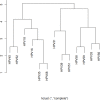Epidemiology and genotypes analysis of human papillomavirus infection in Beijing, China
- PMID: 38229145
- PMCID: PMC10790403
- DOI: 10.1186/s12985-024-02292-3
Epidemiology and genotypes analysis of human papillomavirus infection in Beijing, China
Abstract
Background: This study aimed to investigate the epidemiology of high-risk human papillomavirus (HPV) in the female population in Beijing, China, and identify the relationship between HPV genotypes and host factors.
Methods: HPV testing was performed on women aged 15-89 (mean age 38.0 ± 10.9 years) from Beijing in 2020. High-risk HPV genotyping real-time polymerase chain reaction was used to determine HPV genotypes. The overall prevalence, age-specific prevalence, genotype distribution, and the correlation between HPV genotypes and cervical cytology were analyzed.
Results: Among the 25,344 study participants, the single and double infection rates were 18.8% (4,777/25,344) and 4.2% (1,072/25,344), respectively. A total of 6,119 HPV-positive individuals were found to have 91.6% negative results for intraepithelial lesion or malignancy (NILM), 5.8% atypical squamous cells of undetermined significance (ASC-US), 0.9% low-grade squamous intraepithelial lesion (LSIL), and 1.7% high-grade squamous intraepithelial lesion (HSIL). In single HPV infections, the HPV16 genotype was highly associated with cervical cytology severity (χ2 trend = 172.487, P < 0.001). Additionally, HPV infection rates increased gradually with age, and statistical differences were observed across age groups (χ2 = 180.575; P < 0.001). High-risk HPV genotypes were highly prevalent in women below 25 years of age and those aged 55-59 years. Cluster analysis revealed that the 13 HPV genotypes could be roughly divided into two groups in a single infection; however, patterns of infection consistent with biological characteristics were not observed.
Conclusion: High-risk HPV was found in 24.1% of outpatients, with HPV52, HPV58, HPV16, HPV39, and HPV51 being the most common high-risk genotypes. Single high-risk HPV infection was predominant. HPV16, HPV39, HPV51, and HPV52 were associated with cervical lesion progression. HPV16 infection was especially worrying since it aggravates cervical lesions. Because the infection rates of the 13 HPV genotypes differed by age, the peak HPV infection rate should not guide vaccination, screening, and prevention programs. Instead, these initiatives should be tailored based on the regional HPV distribution characteristics. Moreover, it was determined that Beijing's populace needed to receive treatment for HPV39 infection.
Keywords: Ages; Cervical cancer; Cervical lesions; Cluster analysis; High-risk HPV.
© 2024. The Author(s).
Conflict of interest statement
The authors declare no competing interests.
Figures
Similar articles
-
Epidemiological study of HPV infection in 40,693 women in Putian: a population study based on screening for high-risk HPV infection.BMC Infect Dis. 2022 Nov 28;22(1):893. doi: 10.1186/s12879-022-07893-3. BMC Infect Dis. 2022. PMID: 36443703 Free PMC article.
-
[Evaluation of CIN2+ /CIN3+ risk of different HPV subtypes infection combined with abnormal cytology status].Zhonghua Zhong Liu Za Zhi. 2018 Mar 23;40(3):232-238. doi: 10.3760/cma.j.issn.0253-3766.2018.03.015. Zhonghua Zhong Liu Za Zhi. 2018. PMID: 29575846 Chinese.
-
Prevalence of human papillomavirus genotypes and precancerous cervical lesions in a screening population in Beijing, China: analysis of results from China's top 3 hospital, 2009-2019.Virol J. 2020 Jul 13;17(1):104. doi: 10.1186/s12985-020-01383-1. Virol J. 2020. PMID: 32660490 Free PMC article.
-
Prevalence and genotype distribution of human papillomavirus infection among female outpatients in Northeast China: a population-based survey of 110,927 women.Arch Gynecol Obstet. 2023 Jul;308(1):35-41. doi: 10.1007/s00404-022-06653-7. Epub 2022 Jul 29. Arch Gynecol Obstet. 2023. PMID: 35904609 Review.
-
Prevalence and distribution of human papillomavirus genotypes in cervical intraepithelial neoplasia in China: a meta-analysis.Arch Gynecol Obstet. 2020 Dec;302(6):1329-1337. doi: 10.1007/s00404-020-05787-w. Epub 2020 Sep 10. Arch Gynecol Obstet. 2020. PMID: 32914222 Free PMC article. Review.
Cited by
-
Prevalence and genotype distribution of human papillomavirus infection among 66000 women from 2014 to 2023 in the plateau region of Southwest China.Virol J. 2024 Aug 6;21(1):176. doi: 10.1186/s12985-024-02447-2. Virol J. 2024. PMID: 39107796 Free PMC article.
-
Prevalence and Genotyping of Human Papillomavirus Infections in Females and Males in Zhejiang, China.Infect Drug Resist. 2024 Nov 29;17:5325-5334. doi: 10.2147/IDR.S484519. eCollection 2024. Infect Drug Resist. 2024. PMID: 39628831 Free PMC article.
-
Quality Assurance in Cervical Cancer Screening: Evaluation of Sample Adequacy in HPV DNA Testing.J Med Virol. 2025 Jul;97(7):e70482. doi: 10.1002/jmv.70482. J Med Virol. 2025. PMID: 40600419 Free PMC article.




